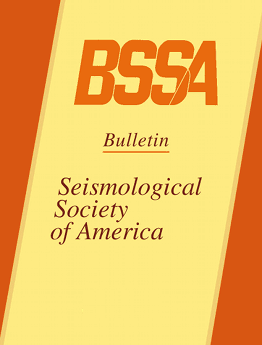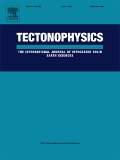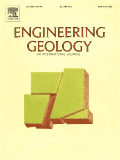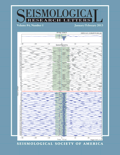
BULLETIN OF THE SEISMOLOGICAL SOCIETY OF AMERICA
metrics 2024
Exploring the depths of Earth's mysteries through seismology.
Introduction
BULLETIN OF THE SEISMOLOGICAL SOCIETY OF AMERICA is a premier journal published by the Seismological Society of America, dedicated to advancing research in the field of seismology and related disciplines. Since its inception in 1969, this journal has garnered significant recognition, evidenced by its impressive Q1 category rankings in both Geochemistry and Petrology, and Geophysics, alongside a solid standing within the Earth and Planetary Sciences Scopus rankings. The journal is esteemed for publishing high-quality, peer-reviewed articles that contribute to the understanding of seismic activities and their implications on a global scale. With a commitment to facilitating the dissemination of critical findings, it serves as an essential resource for researchers, professionals, and students alike who are engaged in the dynamic and vital study of the Earth’s processes. While the journal is not Open Access, it continues to provide vital insights and methodologies that shape the future of geophysical research.
Metrics 2024
 1.10
1.10 2.60
2.60 2.70
2.70 170
170Metrics History
Rank 2024
Scopus
IF (Web Of Science)
JCI (Web Of Science)
Quartile History
Similar Journals

Seismic Instruments
Empowering seismic research through cutting-edge instrumentation.Seismic Instruments is a prestigious academic journal dedicated to advancing the field of geophysical instrumentation and its applications in seismic studies. Published by PLEIADES PUBLISHING INC, this journal serves as a crucial resource for researchers, professionals, and students interested in the development, evaluation, and deployment of seismic instrumentation technologies. Although it does not currently offer open access, it provides a comprehensive platform for high-quality research articles, reviews, and technical notes that explore the latest innovations and findings in seismic studies. With an ISSN of 0747-9239 and an E-ISSN of 1934-7871, Seismic Instruments aims to foster collaboration and knowledge exchange among the global academic community, emphasizing the importance of instrumentation in understanding seismic activity and its implications for engineering, environmental science, and hazard mitigation.

TECTONOPHYSICS
Exploring the Dynamics of Our Planet's TectonicsTECTONOPHYSICS is a leading journal published by Elsevier that has been at the forefront of earth and planetary sciences since its inception in 1964. With both its print and e-ISSN identifiers (0040-1951 and 1879-3266), the journal offers a reputable platform for disseminating high-quality research in Earth-Surface Processes and Geophysics, proudly positioned in the Q1 category for both fields in 2023. With a Scopus ranking of #43 out of 179 in Earth-Surface Processes and #43 out of 165 in Geophysics, TECTONOPHYSICS demonstrates a strong impact, making it an essential resource for researchers and professionals involved in the geological and geophysical sciences. Published in the Netherlands, TECTONOPHYSICS is committed to advancing knowledge in tectonics and related disciplines, fostering innovative research that impacts our understanding of Earth's dynamic processes. The journal invites contributions that push the boundaries of science, making it a must-read for academia and industry alike.

GEOTECTONICS
Exploring Earth's Mysteries, One Tectonic Shift at a Time.GEOTECTONICS is a distinguished academic journal published by PLEIADES PUBLISHING INC, focusing on key developments in the field of geology. Established in 1978, the journal has dedicated itself to exploring the intricate processes and phenomena associated with Earth's tectonic systems, making substantial contributions to Earth and Planetary Sciences. With an impressive impact factor reflected in its Q2 ranking within the Scopus category of Geology, GEOTECTONICS stands out as a valuable resource for researchers, professionals, and students alike. The journal offers a platform for rigorous peer-reviewed research that spans both fundamental theories and practical applications in geosciences, affirming its significance in fostering academic discourse and advancing geological knowledge. Although it currently does not offer open access, the journal's accessible format and continued publication through to 2024 ensures that it remains at the forefront of geoscientific inquiry.

Geodynamics & Tectonophysics
Bridging Disciplines for a Deeper Understanding of EarthGeodynamics & Tectonophysics, published by the esteemed Russian Academy of Sciences, Siberian Branch, Inst Earths Crust, is a pivotal open-access journal that has been contributing to the scientific discourse on Earth's dynamic processes since 2010. With an ISSN of 2078-502X, this journal serves as a vital platform for researchers and professionals interested in the fields of Earth-Surface Processes, Economic Geology, Geology, and Geophysics, holding a Q3 ranking in each of these categories as of 2023. The journal is based in Irkutsk, Russia, and encompasses a broad spectrum of topics, fostering interdisciplinary collaboration and innovation. Researchers can access cutting-edge studies and insights, engaging with a community committed to advancing our understanding of geodynamics and tectonic phenomena. With a sustained commitment to quality and accessibility, Geodynamics & Tectonophysics plays a critical role in addressing pressing geological concerns and advancing global geological research.

Journal of Asian Earth Sciences-X
Connecting Researchers to Tackle Global Environmental ChallengesJournal of Asian Earth Sciences-X, a distinguished publication by ELSEVIER, is at the forefront of Earth and planetary sciences, particularly focusing on the dynamic fields of geology and earth-surface processes. As an Open Access journal since 2019, it provides unparalleled access to high-quality research, fostering global collaboration and dissemination of knowledge. With an impressive impact factor and ranking in the Q2 category for both Earth-Surface Processes and Geology, it serves as a crucial platform for researchers, professionals, and students alike to share their findings and insights. Situated in the United Kingdom, the journal thrives on contributions that enhance our understanding of Asian geosciences within a broader global context, aiming to tackle major challenges such as climate change and natural resource management. By bridging regional studies with global perspectives, the Journal of Asian Earth Sciences-X is not only a vital resource for academia but also supports sustainable development initiatives across the region.

ENGINEERING GEOLOGY
Advancing the Intersection of Geology and EngineeringENGINEERING GEOLOGY, published by Elsevier, is a leading journal in the fields of Geology and Geotechnical Engineering, recognized by its prestigious Q1 ranking in both categories for 2023. With a deep focus on the application of geological principles to engineering practices, this journal plays a vital role in advancing knowledge and methodologies that enhance infrastructure development and environmental sustainability. Operating since 1965, the journal disseminates high-quality research, offering insights that foster innovation in geotechnical assessments and geological hazard evaluation. Researchers and professionals benefit from its rigorous peer-review process and impactful studies, bolstered by a strong Scopus ranking - #4 in Geology and #3 in Geotechnical Engineering, both placing it in the top 2% of its field. Although there is no Open Access option available, the journal facilitates significant academic discourse, making it an essential resource for anyone involved in the intersection of geology and engineering.

SEISMOLOGICAL RESEARCH LETTERS
Pioneering insights into the dynamic world of earthquakes.SEISMOLOGICAL RESEARCH LETTERS is a leading journal in the field of geophysics, published by the Seismological Society of America. With its ISSN 0895-0695 and E-ISSN 1938-2057, this prestigious publication serves as a vital platform for disseminating groundbreaking research and advancements in seismological science. The journal boasts an impressive Q1 categorization in the 2023 rankings and ranks 23rd out of 165 in Earth and Planetary Sciences, Geophysics, placing it within the 86th percentile among its peers. Spanning an illustrious history from its origination in 1984 to its ongoing contributions through 2024, it is dedicated to fostering a deeper understanding of seismic phenomena. Although it currently does not offer open access, researchers, professionals, and students can benefit from timely insights and comprehensive studies presented in its pages. Set within the heart of the United States, the journal stands as a cornerstone in geophysics, connecting a global community eager to advance their knowledge and impact in the field.

EARTHQUAKE SPECTRA
Unraveling the complexities of seismic events with expertise.EARTHQUAKE SPECTRA, published by SAGE PUBLICATIONS INC, is a premier journal dedicated to the field of geophysics, geotechnical engineering, and engineering geology, with a specific focus on seismic phenomena. Issued both in print (ISSN: 8755-2930) and electronically (E-ISSN: 1944-8201), the journal has maintained its position as a leading source of high-quality research since its inception in 1984. Recognized in the 2023 Category Quartiles as Q1 in both geophysics and geotechnical engineering, it is highly regarded in the academic community, ranking 11 out of 165 in its field, placing it in the 93rd percentile of Earth and Planetary Sciences, and 30 out of 229 for geotechnical engineering with an 87th percentile standing. With a commitment to advancing knowledge and practice in earthquake engineering, EARTHQUAKE SPECTRA publishes original research, case studies, and critical reviews that inform the design and construction practices related to seismic events. Although it does not currently offer open access, the journal's impact on the discipline remains significant, making it an essential resource for researchers, professionals, and students dedicated to understanding and mitigating the effects of earthquakes.

Ingegneria Sismica
Shaping the future of structural safety and risk management.Ingegneria Sismica, a premier journal published by PATRON EDITORE S R L, serves as an essential platform for the dissemination of research in the fields of building and construction, geotechnical engineering, and safety risk management. With a focus on earthquake engineering and structural safety, the journal has established itself as a prominent source of knowledge since its inception in 2010. The journal holds an impressive Q2 classification in multiple categories, including Building and Construction and Geotechnical Engineering, reflecting its significant impact within these disciplines. Despite its Italian roots, it appeals to an international audience of researchers, professionals, and students dedicated to advancing the understanding of seismic resilience and risk mitigation strategies. Although open access is not currently available, the potential for knowledge sharing and innovative methodologies presented in the articles continues to attract a robust readership. With its commitment to excellence and relevance, Ingegneria Sismica is poised to shape future discourse in engineering practices aimed at enhancing safety, reliability, and quality within seismic zones.

JOURNAL OF SEISMOLOGY
Connecting scholars to the pulse of the planet.Welcome to the JOURNAL OF SEISMOLOGY, an esteemed publication in the field of Earth sciences, dedicated to the study of seismic phenomena and their implications on geophysical and geochemical processes. Published by SPRINGER and based in the Netherlands, this journal has been contributing to the academic community since 1997 and is set to continue through 2024. With an impressive ranking within the quartiles—Q2 in Geophysics and Q3 in Geochemistry and Petrology for 2023—this journal is a pivotal resource for researchers and professionals seeking to expand their understanding of seismic activities, earthquake mechanics, and related geological interactions. Despite not offering open access, it remains a highly regarded platform for disseminating rigorous research and findings in Earth and Planetary Sciences, sustaining a global readership keen on advancing their knowledge in this dynamic field. The JOURNAL OF SEISMOLOGY is committed to fostering scholarly exchange and advancing scientific inquiry, making it an invaluable asset for students, researchers, and professionals alike.